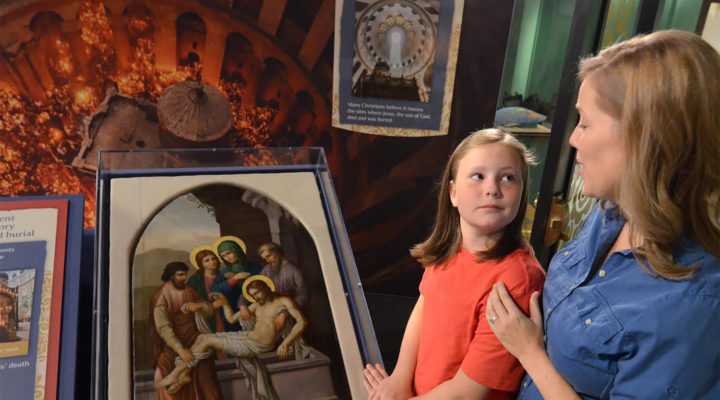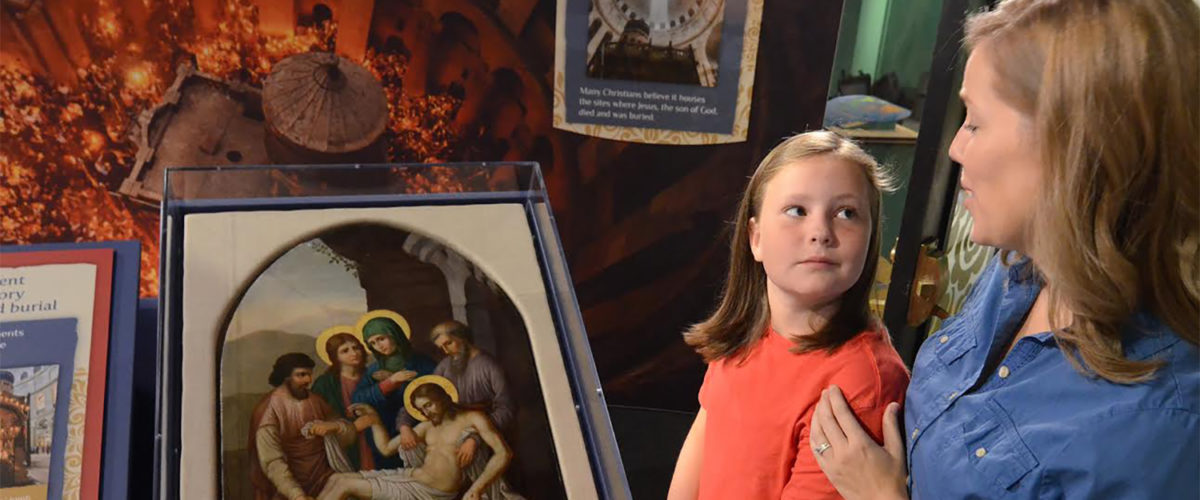Each year, more than 330 million people around the world journey to sacred places to perform acts of devotion, express faith or seek enlightenment or healing.
From Oct. 1 to Dec. 31, visitors to Baylor University’s Mayborn Museum Complex in Waco, Texas, will learn about those pilgrimages through the exhibition National Geographic Sacred Journeys.
The exhibit, created with National Geographic photography, recreates places, spaces and events so visitors can observe, discuss and learn about the history and beliefs behind spiritual travels around the world.
This marks the only time the 7,000-square-foot exhibition will travel from The Children’s Museum of Indianapolis. The exhibit opened there in 2015.
The eight featured sites replicated in the exhibition include:
- The Western Wall of the Second Jewish Temple in Jerusalem, Israel.
- Dome of the Rock mosque in Jerusalem, the site of Muhammed’s ascent to heaven.
- The Church of the Holy Sepulchre in Jerusalem, site of Jesus’ crucifixion.
- The Grand Mosque in Mecca, Saudi Arabia, to which all Muslims are expected to make a pilgrimage, or Hajj, once in their lives.
- Tepeyac Hill and the Roman Catholic Basilica of Our Lady of Guadalupe in Mexico City, Mexico.
- Allahabad and Sangam at the confluence of three rivers sacred to Hindus at the Ganges River in India, site of some of the largest gatherings of humans on Earth.
- Bodh Gaya, birthplace of Buddhism, and the Bodh Tree, where Gautama Buddha achieved enlightenment in Bihar, India.
- Caves in the bluffs along the Dead Sea in Qumran, Israel, where the Dead Sea Scrolls were discovered.
- Among the artifacts that will be featured in the exhibition are fragments of the Dead Sea scrolls, a large stone from the Western Wall in Jerusalem, Jewish devotional objects taken into space by former astronaut David Wolf, the trunk Brigham Young carried from New York to Utah, a piece of the Kiswa (a gold-embroidered fabric, which drapes the Kaaba in Mecca), a throne built for the Dalai Lama’s U.S. visit in 2010, a replica of the Shroud of Turin, and a statue of Ganesh (Hindu god of good fortune).
“Children and families will have the opportunity to learn about pilgrimages, festivals and important objects connected to a variety of sacred sites in the world.”
The personal stories of children and families who participate in sacred journeys or practices are woven into the exhibit’s story line, with artifact cases and text panels referencing those accounts.
“Children and families will have the opportunity to learn about pilgrimages, festivals and important objects connected to a variety of sacred sites in the world,” said Charles Walter, director of Mayborn Museum Complex.
In creating the exhibit, staff of The Children’s Museum of Indianapolis worked closely with local religious leaders and a national panel of academic experts in the fields of humanities, theology, world cultures and religious studies. The advisers shaped exhibit content to ensure that the most authentic artifacts, texts and other exhibit elements were selected and portrayed in an appropriate manner so they may be understood by visitors with diverse perspectives.
“Many Americans associate the idea of pilgrimage with the Middle Ages, but in fact it is a huge reality in the present world, something that affects literally billions of people,” said Philip Jenkins, professor of history in Baylor’s Institute for Studies of Religion.
“Pilgrimage also provides a wonderful way of understanding religious impulses as they are expressed in different world faiths,” Jenkins said. “So we are dealing with something richly educational, something that provides a unique way of understanding different religious traditions, but it’s also breathtaking in terms of the beautiful places and buildings that will be explored.”
— This story was originally published at Baylor.edu.


